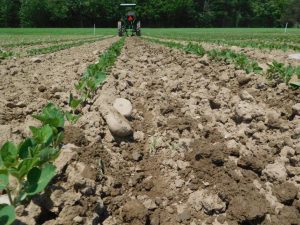Bill Cox and Eric Sandsted
Soil and Crop Sciences Section, School of Integrative Plant Science, Cornell University

We initiated a 4-year study at the Aurora Research Farm in 2015 to compare different sequences of the corn, soybean, and wheat/red clover rotation in conventional and organic cropping systems under recommended and high input management during the 3-year transition period (2015-2017) from conventional to an organic cropping system. We provided a detailed discussion of the various treatments and objectives of the study in a previous news article (https://blogs.cornell.edu/whatscroppingup/2015/07/23/emergence-early-v4-stage-and-final-plant-populations-v10-psnt-values-v4-and-weed-densities-v12-in-corn-under-conventional-and-organic-cropping-systems/). Unfortunately, we were unable to plant wheat after soybean in the fall of 2016 because green stem in soybean compounded with very wet conditions in October and early November delayed soybean harvest until November 9, too late for wheat planting. Consequently, corn followed soybean as well as wheat/red cover in 2017 so we are now comparing different sequences of the corn-soybean-wheat/red clover rotation with a corn-soybean rotation (Table 1). This article will focus on corn plant densities at the V9 stage after rotary hoeing (V1-2 stage), a close to the row cultivation (V3 stage), and three subsequent in-row cultivations (V5, V6-7, and V7-8 stages) in organic corn.
We reported in a previous article (https://blogs.cornell.edu/whatscroppingup/2017/06/05/organic-and-conventional-corn-have-similar-emergence-and-early-plant-densities-in-2017/) that organic corn and conventional corn had similar plant densities in all treatments at the V1-2 stage (June 2), a few hours before the rotary hoe operation. Organic corn, however, had 5.5% lower plant densities 10 days later at the V3 stage, whereas conventional corn had similar plant densities at the V3 stage compared to the V1-2 stage (Table 2). We attributed the 5.5% reduction in plant densities to rotary hoe damage (https://blogs.cornell.edu/whatscroppingup/2017/07/06/rotary-hoe-operation-at-the-v1-2-stage-decreases-organic-corn-plant-densities-by-5-5-but-has-limited-effect-on-organic-soybean-plant-densities/). Consequently, organic corn with recommended inputs (~30,000 kernels/acre seeding rate) had plant populations of only ~24,500 to ~25,500 plants/acre at the V3 stage, too low for maximum yields in New York. We speculated in the previous rotary hoe article that organic corn seeding rate recommendations may have to be increased to ~33,000 kernels/acre.
Unfortunately, after a close to the row cultivation and three subsequent in-row cultivations, plant densities in organic corn were further reduced by 3.5% with final plant stands now below 24,600 plants/acre in all six recommended organic corn treatment combinations (Table 2). Again, conventional corn had similar plant densities at the V3 and V8 stages, so we attributed the 3.5% reduction in organic corn to cultivation damage. We are not sure which of the four subsequent cultivations after the rotary hoe operation resulted in most of the 3.5% reduction. We did see some corn tipping damage at the V7-8 operation because of the height of the corn but the damage was estimated to be only ~0.5%. We suspect that most of the damage came during the in-row cultivation when thrown soil from the close cultivation buried some of the corn plants.
We have recommended seeding rates of ~30,000 kernels/acre for conventional corn in New York, despite criticism from some industry personnel, farmers, and academic colleagues in other states. We have maintained these recommended seeding rates because on most occasions final stands of 26,000 to 28,000 plants/acre have resulted in maximum economic yields (https://scs.cals.cornell.edu/sites/scs.cals.cornell.edu/files/shared/documents/wcu/WCUvol23no1.pdf). Ironically, the high input organic corn treatments (seeding rates of ~35,000 kernels/acre) had final plant stands of ~27,000 to ~29,000 plants/acre in this study (Table 2), close to optimum for maximum yields in New York. Apparently, organic corn in New York should be planted at ~34,000 kernels/acre. We attributed the 7% lower yield in organic compared with conventional corn in 2016 to lower plant densities (https://blogs.cornell.edu/whatscroppingup/2016/11/28/organic-corn-only-yields-7-lower-than-conventional-corn-during-the-second-transition-year/). Likewise, organic corn with high inputs yielded 6.5 to 7.0% greater than organic corn with recommended inputs in two of three treatment comparisons in 2016, presumably because of the low final stands in the organic recommended input treatment. If high input organic corn yields greater than organic corn with recommended inputs in 2017, we will change the recommended seeding rate for organic corn to ~34,000 kernels/acre in the 2018 Cornell Guide for Integrated Field Crop Management.



